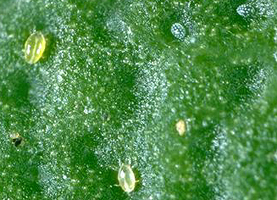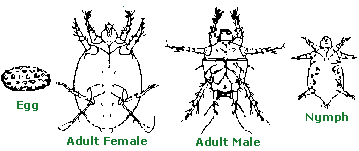|
|
Back to Pest Identification and Diagnosis
 |

|
|
|
Broad Mites From: University of California |
Life Cycle |
| DESCRIPTION | |
|
Adults: Broad mites are almost microscopic (less than 0.2 millimeter long). They are translucent and colorless to pale brown. There are four pairs of legs; the last pair in the female ends in a long hair; the last pair on the male ends in a strong claw.
Eggs: The egg is elliptical, translucent, colorless, about 0.08 millimeter long, and is covered by 29 to 37 whitish bumps. Larvae: The young broad mite has three pairs of legs and is whitish due to minute ridges on the skin. It is about 0.1 millimeter long. |
|
| BIOLOGY | |
|
Host Plants: Broad mites infest African violet, ageratum, azalea, begonia, dahlia, gerbera, gloxinia, ivy, jasmine, impatiens, lantana, marigold, peperomia, snapdragon, verbena, and zinnia.
Damage: Infested plants become unthrifty. Leaves curl downward and turn coppery or purplish. Internodes shorten and lateral buds break more than normal. This new growth may also be stunted or killed, which forces out additional shoots. Flowers are distorted and fail to open normally. Unless controlled, broad mites usually destroy the commercial value of infested ornamental corps. Broad mites damage flowers and foliage of begonia and cyclamen, and bronze the lower leaf surfaces. Broad mites are so small that they are virtually invisible on the host plant even with a good hand lens. Life Cycle: Female broad mites lay 30 to 76 eggs on the leaf surface over an 8- to 13-day oviposition period. Unmated females lay male eggs; mated females usually lay four female eggs for every male egg. The larvae hatch in 2 or 3 days and emerge from the egg shell to feed. Larvae are slow moving and do not disperse far. In 2 or 3 days, the larvae develop into a quiescent larval stage. Quiescent female larvae become attractive to the males which pick them up and carry them to the new foliage. Males and females are very active, but the males apparently account for much of the dispersal of a broad mite population in their frenzy to carry the quiescent female larvae to new leaves. When females emerge from the quiescent stage, males immediately mate with them. Males live 5 to 9 days; females live 8 to 13 days. |
|
| MANAGEMENT STRATEGIES | |
|
Cultural control: Broad mites are very sensitive to heat. Lowering infested plants into water held at 43 to 49°C for 15 minutes will destroy broad mites without damaging the plants.
Pesticides: Broad mites are susceptible to various miticides. However, they are more difficult to control in winter than in summer due to lower greenhouse temperatures. For specific chemical control recommendations, consult the Cooperative Extension Service. |
Back to Pest Identification and Diagnosis
 |
(C) Regents of the University of
Minnesota. All rights reserved. |
 |
 |